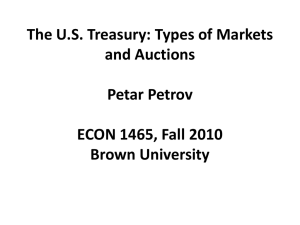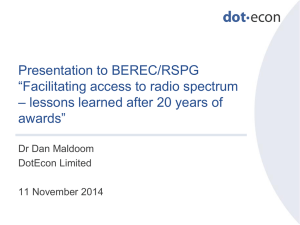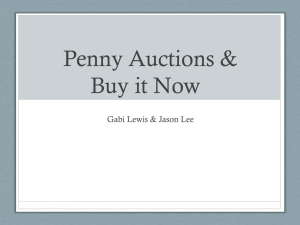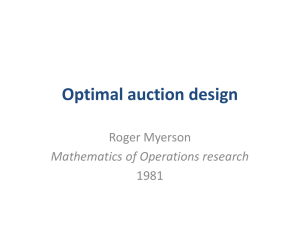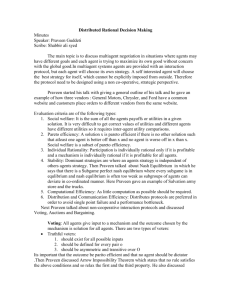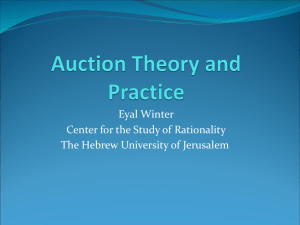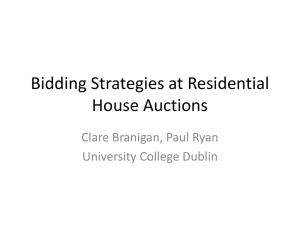Prior-free auctions
advertisement
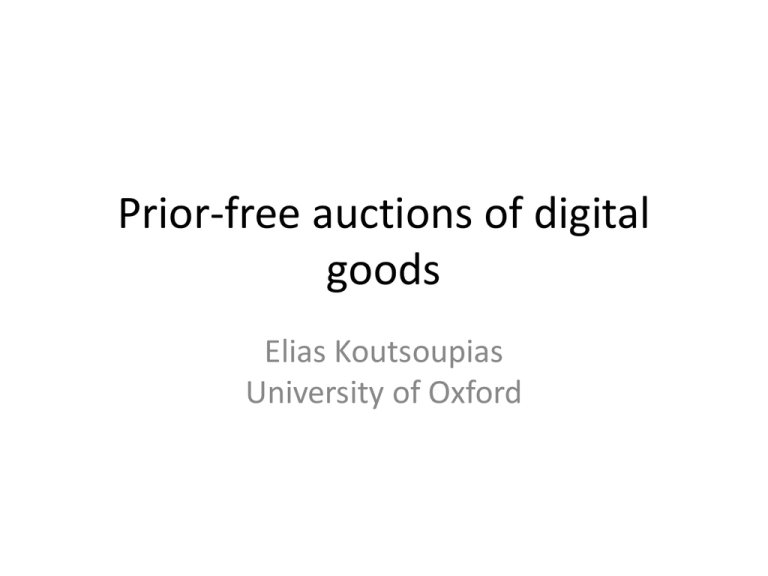
Prior-free auctions of digital
goods
Elias Koutsoupias
University of Oxford
TheMyerson
landscape
auctions
designed an optimalof
auction
for
single-parameter domains
and many players
Combinatorial
The optimal auction maximizes the welfare of
some
virtual
valuations
Many items
Major
open
(additive valuations)
problem
Benchmark for evaluating auctions?
Identical items In the Bayesian setting, the answer is
(limited supply)
straightforward: maximize the expected revenue
Extending
the results
of Myerson
to many items is
(with respect
to known
probability
distributions)
Myerson
Identical items still an open problem
• (1981)
Even for a single bidder
(unlimited supply)
• And for simple probability distributions,
such as the uniform distribution
Single item
Symmetric, F(2)
Bayesian
Prior-free
Asymmetric, M(2)
Multi-unit auction: The setting
The Bayesian setting
• Each bidder i has a valuation vi for the item
which is drawn from a publicly-known
probability distribution Di
• Myerson’s solution gives an auction which
maximizes the expected revenue
The prior-free setting
• Prior information may be costly or even
impossible
• Prior-free auctions:
– Do not require knowledge of the probability
distributions
– Compete against some performance benchmark
instance-by-instance
Benchmarks for prior-free auctions
• Bids: Assume v1> v2>…> vn
• Compare the revenue of an auction to
– Sum of values: Σi vi (unrealistic)
– Optimal single-price revenue: maxi i * vi
(problem: highest value unattainable; for the same
reason that first-price auction is not truthful)
– F(2) (v) = maxi>=2 i * vi
Optimal revenue for
• Single price
• Sell to at least 2 buyers
– M(2) (v) : Benchmark for ordered bidders with dropping
prices
F(2) and M(2) pricing
30
25
20
Value
15
M^(2) price
F^(2) price
10
5
0
1
2
3
4
5
6
7
8
F(2) and M(2)
• Let v1, v2 , …, vn be the values of the bidders in
the given order
• Let v(2) be the second maximum
We call an auction c-competitive if its revenue
is at least F(2)/c or M(2)/c
Motivation for M(2)
F(2) <= M(2) <= log n * F(2)
• An auction which is constant competitive
against M(2) is simultaneously near optimal for
every Bayesian environment of ordered
bidders
• Example 1: vi is drawn from uniform
distribution [0, hi], with h1 <= … <= hn
• Example 2: Gaussian distributions with nondecreasing means
Some natural offline auctions
• DOP (deterministic optimal price) : To profi
each bidder offer the
t Not competitive.
optimal single price for the other bidders.
• RSOP (random sampling
optimal price)
profit
– Partition the bidders into two sets A and B randomly
– Compute the optimal single price for each part and offer it to each
bidder of the other part
4.68-competitive. Conjecture: 4-competitive
• RSPE (random sampling profit extractor)
b
– Partition the bidders into
B randomly
b1 two 2sets A and
p
3
price
– Compute the optimal single-price
revenue
forb3each part and try to
b5
b4 part b
extract it from the other
7
b
6
4-competitive
price
• Optimal competitive ratio in 2.4 .. 3.24
In this talk: two extensions
• Online auctions
– The bidders are permuted randomly
– They arrive one-by-one
– The auctioneer offers take-it-or-leave prices
• Offline auctions with ordered bidders
– Bidders have a given fixed ordering
– The auction is a regular offline auction
– Its revenue is compared against M(2)
Online auctions
Benchmark F(2)
Joint work with George Pierrakos
Online auction - example
Prices :
-
4
4
3
Bids :
4
6
3
…
Algorithm Best-Price-So-Far (BPSF):
Offer the price which maximizes the
single-price revenue of revealed bids
F(2) pricing
30
25
20
Value
15
F^(2) price
10
5
0
1
2
3
4
5
6
7
8
Related work
Prior-free mechanism
design
-offline mechanisms mostly
-online with worst-case arrivals
RSOP is 7600-competitive [GHKWS02]
15-competitive [FFHK05]
4.68-competitive [AMS09]
Conjecture1: RSOP is 4-competitive
Secretary model
-generalized secretary
problems
-mostly social welfare
-from online algorithms to
online mechanisms
Majiaghayi, Kleinberg, Parkes [EC04]
Our approach:
from offline mechanisms to online
mechanisms
Results
– Disclaimer1: our approach does not address arrival time misreports
– Disclaimer2: our approach heavily relies on learning the actual values
of previous bids
The competitive ratio of Online
Sampling Auctions is between 4 and 6.48
Best-Price-So-Far has constant competitive ratio
From offline to online auctions
Transform any offline mechanism M into an
online mechanism
M
bj
…
pπ(1) pπ(2)
pπ(j-1) pπ(j)
If ρ is the competitive ratio of M, then the
competitive ratio of online-M is at most 2ρ
Pick M=offline 3.24-competitive auction of
Hartline, McGrew [EC05]
Proof of the Reduction
M
bπ(t)
…
1
r
F (2) (bp (1),...,bp (t ) )
1 1 (2)
F (bp (1),...,bp (t ) )
tr
random order assumption
-let F(2)(b1,…, bn)=kbk
æ t öæ n - t ö
ç ÷ç
÷
-w.prob.è møè k - mø
-for m≥2,
the first t bids have exactly m of the k high bids
æ nö
ç ÷
è kø
F(2) (bp (1) ,… ,bp (t ) ) ³ mbm ³ mbk -w. prob.
-therefore overall profit ≥
æ t öæ n - t ö
÷
n min{t,k} ç ÷ç
è møè k - mø 1 1
mbk
å å
æ
ö
n
t
r
t= 2 m= 2
ç ÷
è kø
æ t öæ n - t ö
ç ÷ç
÷
è møè k - mø
k -1
× kbk
=
bk =
kr
r
k -1
æ nö
ç ÷
è kø
profit from t≥
11
mbk
tr
Ordered bidders
Benchmark M(2)
Joint work with Sayan Bhattacharya, Janardhan
Kulkarni, Stefano Leonardi, Tim Roughgarden,
Xiaoming Xu
M(2) pricing
30
25
20
Value
15
M^(2) price
10
5
0
1
2
3
4
5
6
7
8
History of M(2) auctions
• Leonardi and Roughgarden [STOC 2012]
defined the benchmark M(2)
• They gave an auction which has competitive
ratio O(log* n)
Our Auction
Revenue guarantee: Proof sketch
Bounding the revenue of vB
• Prices are powers of 2
• If there are many values at a price level, we
expect them to be partitioned almost evenly
among A and B.
• Problem: Not true because levels are biased.
They are created based on vA (not v).
• Cure: Define a set of intervals with respect to v
(not vA) and show that
– They are relatively few such intervals
– They are split almost evenly between A and B
– They capture a fraction of the total revenue of A
Open issues
• Offline auctions: many challenging questions
(optimal auction? Competitive ratio of RSOP?)
• Online auctions: Optimal competitive ratio? Is
BPSF 4-competitive?
• Ordered bidders: Optimal competitive ratio?
– The competitive ratio of our analysis is very high
• Online + ordered bidders?
Thank you!
